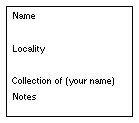Labeling your Mineral Specimens
Importance of labels
Even if YOU know where the mineral was collected, how can others guess what it is or where it came from? One very important thing about a good collection, private, public, scientific or for fun, is that each piece (or similar group) is labeled. The information should at least say what the specimen is and where it came from.
Instead of simply labeling a specimen "from Arkansas,'' use a specific location, such as the "Whatever County quarry on Highway Number So and So, Arkansas."
Important: If you don't know the name of the rock and would like to get it identified later, the location can be a very valuable clue in determining what kind of rock or mineral it really is. Even professionals have had problems with getting a location incorrect, and there are examples in published literature of mistaking where a sample was actually collected. These mistakes could have been prevented by having a label that stayed with the sample.
In addition, you can put other information like "Collected by" and the date on the label, and even notes such as "my grandfather took me on this trip."
There is a difference between field labels and your display labels. A magic marker on a cardboard box is terriffic for your collection from the field. Additional field notes in your notebook will help jog your memory.
 Making your labels
Making your labels
Your computer can serve you well in making your labels. You might want to
print up some labels with blanks that you can fill in by hand. Use your
neatest printing with a permanent ink pen (not a felt tip that will bleed
if it gets wet). If there is a chance the label might get separated from
the rock, write a brief description of the specimen on your label. Some
collectors put a white dot on each sample and give it a code number corresponding
to the label.
A line drawn around the label gives it a nice finished appearance and a guide for cutting it from the page. Be careful of making the label too ornamental, because you want the specimen to receive the attention, not the labels. Don't use a decorative or italic font: they are harder to read. Fonts like Times Roman or Verdana are excellent. Use the same font family on your labels if you want variety. Bold for the name, and regular for the other information. A key point is always make your minerals the center of attention, the star of the show. Everything else is the supporting actors.
Uniformity in your labels is good when the pieces are on display, especially if you are entering your display in a show. Keep in mind that contrast of the color of paper and the color of the ink affect how readable the label is. Black ink on white or light colored paper is very readable and professional.
If your printer can handle a heavy weight paper, you will have less of a problem with humidity causing the labels to curl than with a lightweight paper. Alternately, you could have a printing company that makes business cards print a batch of business card size labels for you. For a display you may be taking to a show, think about gluing the labels onto some heavier cardboard or matt board, so they stand up or lay down properly, or laminate them if they are part of a permanent display.
No label for this mineral? Look at the same piece in UV light (below). If you are sneaky, you can put a number on your piece in invisible ink that glows under black light! It's not appropriate for all rock types, but something to consider.
Keep your labels in the boxes with the specimens in a way that the labels won't get mixed up with other specimens. An unlabeled or mis-labeled specimen does not have nearly as much value as a properly documented piece.
Have a rockhounding friend? If you need a birthday present, why not make up a personalized batch of labels for a gift. Your friend could get inspired.